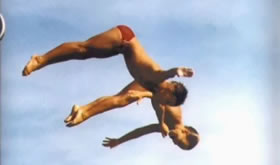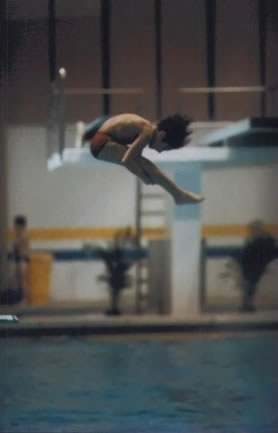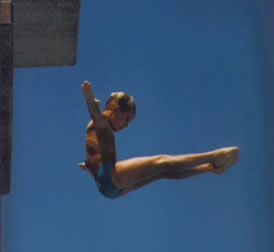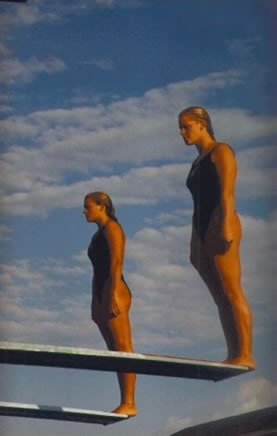 931 SE Ruhnke St, Stuart, FL 34994
931 SE Ruhnke St, Stuart, FL 34994 Email Us
Email Us
Office Hours : Monday to Friday - 8 Am to 4 Pm
Office Hours : Monday to Friday - 8 Am to 4 Pm

As a spectator of the sport of diving, your appreciation is greater if you know what to watch for…what makes a great dive.
TYPES OF DIVES: There are six different groups of platform and springboard dives. The first four types involve rotating in different directions relative to the board and the starting position, while the fifth group includes any dive with a twist and a sixth group involves an armstand starting position on the platform.
Forward Group: The diver faces the front of the board and rotates toward the water. Dives in this group vary from the simple front dive to the difficult forward four and one-half somersault.
Backward Group: All the dives in the backward group begin with the diver on the end of the board with his back to the water. The direction of rotation is away from the board.
Reverse Group: Formerly called "gainers," these dives begin with the diver facing the front of the board (using a forward approach) and rotating toward the board.
Inward Group: The diver stands on the end of the board with his back to the water and rotates toward the board or opposite of the backward group's movement. The earlier term for these dives were "cutaways."
Twisting Group: Any dive with a twist is included in this group. There are four types of twisting dives: forward, backward, reverse, and inward. Because of the many possible combinations, this group includes more dives than any other.
Armstand Group: In platform diving, there is a sixth, unique group of dives called "armstands." Here, the diver assumes a handstand position on the edge of the platform before executing the dive.
BODY POSITIONS: When each type of dive is performed, the diver utilizes one or more of the four different types of body positions:
Tuck: The body is bent at the waist and knees, the thighs are drawn to the chest while the heels are kept close to the buttocks.
Pike: The legs are straight with the body bent at the waist. The arm position is dictated by the particular dive being done or by the choice of the diver.
Straight: This position requires that there be no bend at the waist or knees. However, there may be an arch in the back, depending on the dive. As in the pike position the arm placement is either the diver's choice or defined by the dive done.
Free: This is not an actual body position but a term used to describe the diver's option to use any of the other three positions or combinations thereof when performing a dive which includes somersaults and twists.
PERFORMANCE & JUDGING:
As you watch more and more diving, especially by talented performers, you will observe that although several divers may do exactly the same dive, it never looks quite the same. This is because each individual has different mannerisms, characteristics of movement, strengths and sense of timing-which all add up to an abstract but observable phenomenon called "style".
Style is difficult to assess by any standard, except whether or not you like it. This is why it is hard to judge diving. Even though there are criteria of execution all divers must meet, evaluation remains a subjective process. No matter how well a dive is performed, artistic likes and dislikes of the judges play a large part in the outcome of any contest, and for this reason there are usually differences of opinion among coaches, competitors, judges and spectators about the accuracy of results.
A dive is scored between zero and 10 points in either full or 1/2 -point increments by each judge. A table of the scores and the criteria for how they should be awarded follows:
0 completely failed
1/2 – 2 unsatisfactory
2 1/2 – 4 1/2 deficient
5 – 6 satisfactory
6 1/2 – 8 good
8 1/2 - 10 very good
In classifying a dive into one of the judging categories, certain parts of each dive must be analyzed and evaluated, and an overall award obtained. The parts of a dive are:
Approach: Should be smooth but forceful, showing good form.
Takeoff: Must show control and balance plus the proper angle of landing and leaving for the particular dive being attempted.
Elevation: The amount of spring or lift a diver receives from the takeoff greatly affects the appearance of the dive. Since more height means more time, a higher dive generally affords greater accuracy and smoothness of movement.
Execution: This is most important, for this is the dive. A judge watches for proper mechanical performance, technique, form and grace.
Entry: The entry into the water is very significant because it is the last thing the judge sees and the part probably remembered best. The two criteria to be evaluated are the angle of entry, which should be near vertical, and the amount of splash, which should be as little as possible.
SCORING
Seven judges are used in a National Competition. When the judges awards are given, the two highest and two lowest scores will be eliminated. Usually five judges are used at preliminary or invitational competitions with the one highest and lowest score eliminated. The remaining three scores are totaled and that number will then be multiplied by the degree of difficulty rating assigned to that dive. The DD is predetermined with a table range from 1.2 to 3.6 in one-tenth increments.




